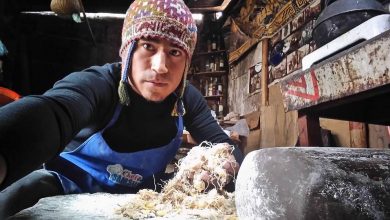Paico, a Surprising and Useful Peruvian Herb

Mounds of green herbs pile up on stands or on cloths set on the ground in Cuzco’s markets. People use lots of fresh herbs in their cooking and for teas and rubs with medicinal import. While some of these are found in the standard Western repertoire of culinary herbs, others provide flavors that do not commonly make their way into foods in Europe, the United States, and Australia.
The market women bundle culinary herbs together into an asnapa. This tends to contain cilantro, mint, parsley, as well as rue and huacatay. These last two are not common culinary herbs. You can buy rue in the herb sections of garden shops in the US, but huacatay has yet to make a stand, although it is available as a non-culinary herb from some seed catalogues, especially for defeating nematodes.
Nevertheless, in Cuzco this bundle plays an important role in people’s tastes. Other herbs, such as thyme, though available here, are rarely used int he kitchen. Most people do not know what it is.
The bundle of herbs contains elements that are Peruvian in origin and ones brought from outside, making flavoring foods and exercise in gastronomic mixing.
Nevertheless, there are many other herbs here, standard ones from the West, and ones from the pre-Columbian past.

One of the latter is paico. You can buy it dried in the markets here in Cuzco in two forms one stronger than the other. Though I have asked, no one seemed to have it fresh. This may be because its primary use in Cuzco is as a medicine in teas and soups.
Nevertheless, paico is the same as the great Mexican herb that is increasingly claiming a place in the United States, epazote. In Latin they both are Dysphania ambrosioides (although they used to be chenopodium ambrosiodes).
Personally, I use epazote whenever I make beans—if it is available fresh, since it is reputed to reduce the gas producing qualities of this legume. It is also wonderful on top of cheese in a fresh quesadilla.
For those who are unaware of it, like cilantro or huacatay, its flavor at first can be a bit or a shock. It is strong and not a scent normally associated with food in the US or Europe. Nevertheless, it imparts a wonderful flavor to food when used that soon captivates.
Because paico is the same, in Latin, as epazote, not only did I ask around in the market where I smelled some dried paico and, sure enough, it smells like epazote. I also poked around online to see if there were any culinary uses for paico in Peruvian cuisine. People here did not mention any.
It is reported as an herb for pachamanca, meat and tubers cooked in a pit with very hot stones, although not al recipes mention it. Others report its use for flavoring chicken. I even found it used blended in a green soup—to be sure one that people insisted had strong medicinal properties.
The greatest surprise came at the end of my search. The great Peruvian daily, El Comercio, published a recipe for a classic dish from Cuzco and claimed paico as an essential seasoning. The dish: Kapchi de Habas, a creamy, cheesy vegetarian stew that is delicious.
In any case, I will take them at their word, even though that use has not been reported to me. Neverthess, I will add paico to my list of culinary herbs, especially when I can get it fresh. It opens new flavor possibilities.




